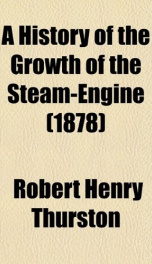a history of the growth of the steam engine

Purchase of this book includes free trial access to www.million-books.com where you can read more than a million books for free. This is an OCR edition with typos. Excerpt from book: metals. They may also be contrived to be serviceable for sundry other pleasant uses, as for the moving of sails in a chimney-corner, the motion of which sails may be applied to the turning of a spit, or the like." Kircher gives an engraving (" Mundus Subterraneus ") showing the last-named application of the seolipile ; and Ercker n ("Aula Subterranea," 1672) gives a picture illustrating their application to the production of a blast in smelting ores. They seem to have been frequently used, and in all parts of Europe, during the seventeenth century, for blowing fires in houses, as well as in the practical work of the various trades, and for improving the draft of chimneys. The latter application is revived very frequently by the modern inventor. Section II. The Period Of ApplicationWorcesTer, Papin, And Savery. We next meet with the first instance in which the expansive force of steam is supposed to have actually been applied to do important and useful work. In 1663, Edward Somerset, second Marquis of Worces-4 ter, published a curious collection of descriptions of his inventions, couched in obscure and singular language, and called " A Century of the Names and Scantlings of Inventions by me already Practised." One of these inventions is an apparatus for raising water by steam. The description was not accompanied by a drawing, but the sketch here given (Fig. 7) is thought probably to resemble one of his earlier contrivances very closely. Steam is generated in the boiler , and thence is led into the vessel e, already nearly filled with water, and fitted up like the apparatus of De Caus. It drives the water in a jet out through the pipe/. The vessel e is then shut oif from the boiler a, is again filled through the pipe h, and the operal iun is repeated. Stuart thi...
Users who have this book
Users who want this book
What readers are saying
What do you think? Write your own comment on this book!
write a commentif you like a history of the growth of the steam engine try:
Other books by this author
Do you want to exchange books? It’s EASY!
Get registered and find other users who want to give their favourite books to good hands!


